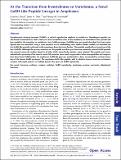At the transition from invertebrates to vertebrates a novel GnRH-like peptide emerges in amphioxus
Abstract
Gonadotropin-releasing hormone (GnRH) is a critical reproductive regulator in vertebrates. Homologous peptides are also found in invertebrates, with a variety of characterized functions. In the amphioxus, an invertebrate that provides the best model for the transition to vertebrates, four GnRH receptors (GnRHRs) were previously described, but their native ligands were not identified. Using a more sensitive search methodology with hidden Markov models, we identified the first GnRH-like peptide confirmed in the amphioxus Branchiostoma floridae. This peptide specifically activated one of the four GnRHRs. Although the primary structure of this peptide was divergent from any previously isolated GnRH peptide, the minimal conserved residues found in all other GnRH superfamily members were retained. The peptide was immunolocalized in proximity of the central canal of the anterior nerve cord, a region where other neuropeptides and receptors have been found. Additionally, the amphioxus GnRH-like gene was positioned in a locus surrounded by syntenic homologs of the human GnRH paralogon. The amphioxus GnRH-like peptide, with its distinct primary structure, activated a receptor with equal potency to multiple ligands that span the GnRH superfamily.
Citation
Roch , G , Tello , J & Sherwood , N 2014 , ' At the transition from invertebrates to vertebrates a novel GnRH-like peptide emerges in amphioxus ' , Molecular Biology and Evolution , vol. 31 , no. 4 , pp. 765-778 . https://doi.org/10.1093/molbev/mst269
Publication
Molecular Biology and Evolution
Status
Peer reviewed
ISSN
0737-4038Type
Journal article
Description
This work was supported by a grant from the Canadian Natural Sciences and Engineering Council (NSERC).Collections
Items in the St Andrews Research Repository are protected by copyright, with all rights reserved, unless otherwise indicated.

